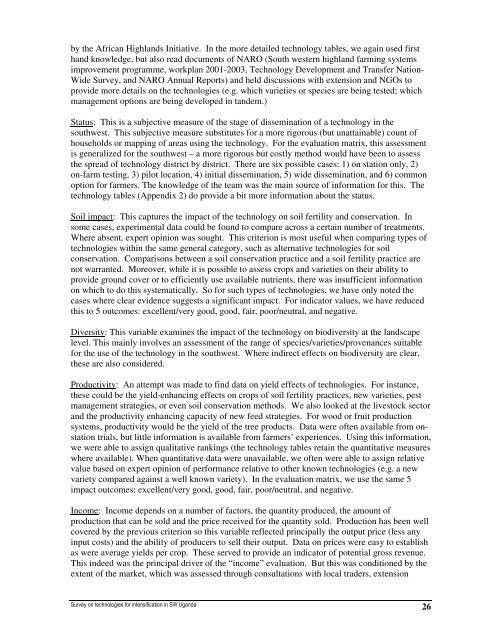Technologies for intensification in SW Uganda ... - Foodnet - cgiar
Technologies for intensification in SW Uganda ... - Foodnet - cgiar
Technologies for intensification in SW Uganda ... - Foodnet - cgiar
Create successful ePaper yourself
Turn your PDF publications into a flip-book with our unique Google optimized e-Paper software.
y the African Highlands Initiative. In the more detailed technology tables, we aga<strong>in</strong> used first<br />
hand knowledge, but also read documents of NARO (South western highland farm<strong>in</strong>g systems<br />
improvement programme, workplan 2001-2003, Technology Development and Transfer Nation-<br />
Wide Survey, and NARO Annual Reports) and held discussions with extension and NGOs to<br />
provide more details on the technologies (e.g. which varieties or species are be<strong>in</strong>g tested; which<br />
management options are be<strong>in</strong>g developed <strong>in</strong> tandem.)<br />
Status: This is a subjective measure of the stage of dissem<strong>in</strong>ation of a technology <strong>in</strong> the<br />
southwest. This subjective measure substitutes <strong>for</strong> a more rigorous (but unatta<strong>in</strong>able) count of<br />
households or mapp<strong>in</strong>g of areas us<strong>in</strong>g the technology. For the evaluation matrix, this assessment<br />
is generalized <strong>for</strong> the southwest – a more rigorous but costly method would have been to assess<br />
the spread of technology district by district. There are six possible cases: 1) on station only, 2)<br />
on-farm test<strong>in</strong>g, 3) pilot location, 4) <strong>in</strong>itial dissem<strong>in</strong>ation, 5) wide dissem<strong>in</strong>ation, and 6) common<br />
option <strong>for</strong> farmers. The knowledge of the team was the ma<strong>in</strong> source of <strong>in</strong><strong>for</strong>mation <strong>for</strong> this. The<br />
technology tables (Appendix 2) do provide a bit more <strong>in</strong><strong>for</strong>mation about the status.<br />
Soil impact: This captures the impact of the technology on soil fertility and conservation. In<br />
some cases, experimental data could be found to compare across a certa<strong>in</strong> number of treatments.<br />
Where absent, expert op<strong>in</strong>ion was sought. This criterion is most useful when compar<strong>in</strong>g types of<br />
technologies with<strong>in</strong> the same general category, such as alternative technologies <strong>for</strong> soil<br />
conservation. Comparisons between a soil conservation practice and a soil fertility practice are<br />
not warranted. Moreover, while it is possible to assess crops and varieties on their ability to<br />
provide ground cover or to efficiently use available nutrients, there was <strong>in</strong>sufficient <strong>in</strong><strong>for</strong>mation<br />
on which to do this systematically. So <strong>for</strong> such types of technologies, we have only noted the<br />
cases where clear evidence suggests a significant impact. For <strong>in</strong>dicator values, we have reduced<br />
this to 5 outcomes: excellent/very good, good, fair, poor/neutral, and negative.<br />
Diversity: This variable exam<strong>in</strong>es the impact of the technology on biodiversity at the landscape<br />
level. This ma<strong>in</strong>ly <strong>in</strong>volves an assessment of the range of species/varieties/provenances suitable<br />
<strong>for</strong> the use of the technology <strong>in</strong> the southwest. Where <strong>in</strong>direct effects on biodiversity are clear,<br />
these are also considered.<br />
Productivity: An attempt was made to f<strong>in</strong>d data on yield effects of technologies. For <strong>in</strong>stance,<br />
these could be the yield-enhanc<strong>in</strong>g effects on crops of soil fertility practices, new varieties, pest<br />
management strategies, or even soil conservation methods. We also looked at the livestock sector<br />
and the productivity enhanc<strong>in</strong>g capacity of new feed strategies. For wood or fruit production<br />
systems, productivity would be the yield of the tree products. Data were often available from onstation<br />
trials, but little <strong>in</strong><strong>for</strong>mation is available from farmers’ experiences. Us<strong>in</strong>g this <strong>in</strong><strong>for</strong>mation,<br />
we were able to assign qualitative rank<strong>in</strong>gs (the technology tables reta<strong>in</strong> the quantitative measures<br />
where available). When quantitative data were unavailable, we often were able to assign relative<br />
value based on expert op<strong>in</strong>ion of per<strong>for</strong>mance relative to other known technologies (e.g. a new<br />
variety compared aga<strong>in</strong>st a well known variety). In the evaluation matrix, we use the same 5<br />
impact outcomes: excellent/very good, good, fair, poor/neutral, and negative.<br />
Income: Income depends on a number of factors, the quantity produced, the amount of<br />
production that can be sold and the price received <strong>for</strong> the quantity sold. Production has been well<br />
covered by the previous criterion so this variable reflected pr<strong>in</strong>cipally the output price (less any<br />
<strong>in</strong>put costs) and the ability of producers to sell their output. Data on prices were easy to establish<br />
as were average yields per crop. These served to provide an <strong>in</strong>dicator of potential gross revenue.<br />
This <strong>in</strong>deed was the pr<strong>in</strong>cipal driver of the “<strong>in</strong>come” evaluation. But this was conditioned by the<br />
extent of the market, which was assessed through consultations with local traders, extension<br />
26
















